This was published 7 years ago
Chiang Mai, northern Thailand: Food tour of Thailand's food bowl mountains with Peter Gilmore
By Peter Barrett
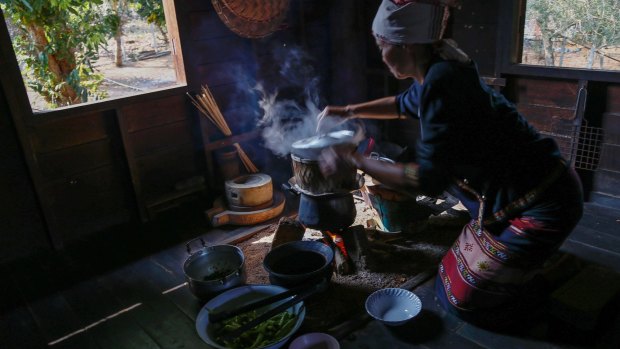
Hot stuff: Cooking with charcoal.
Thick, charcoal smoke is beginning to fill the small, wooden room. Tending an ancient-looking clay oven – essentially a bowl of ashes sitting on a gravel tray catching errant sparks – is a cheerful woman dressed in elegant, traditional clothes of northern Thailand. Next to her, and watching every move, is top Australian chef Peter Gilmore, of Sydney's Quay and Bennelong restaurants. I am watching too, fascinated by the dish she is preparing but more distracted by the fact that the house we are in – perched on stilts in a remote farming village in northern Thailand – is built almost entirely out of teak. I'm hoping this meal won't be our last.
Gilmore and I are here learning about the Royal Project, an initiative that fights deforestation and poverty in Thailand's Chiang Mai province by encouraging farmers to grow edible crops instead of heroin poppies. Founded by His Majesty King Bhumibol Adulyadej in 1969, it's ballooned into a network of 38 research stations experimenting with more than 2000 different crops. The knowledge is then passed on to local farmers who sell their produce back to the Project at fixed prices, providing a stable, reliable and legal income. Surprisingly, a lot of the food grown is actually European (think Italian basil, rosemary and cabbages), thanks to the region's altitude and cooler climate.
As the fire crackles away merrily it becomes clear we are in more danger from smoke inhalation than immolation. But carcinogenic charcoal cooking is much less common in Thailand today and the woman, who runs a nearby noodle restaurant, says she usually cooks with gas.
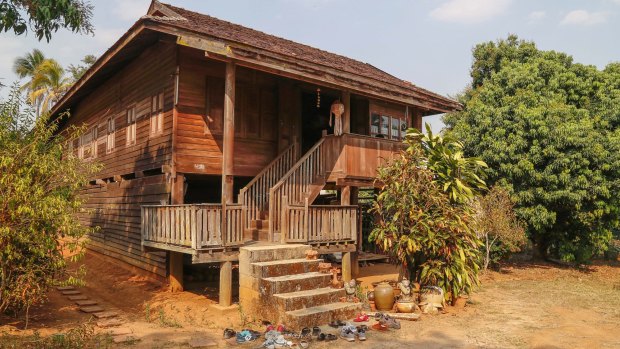
A teak stilt house.
For today's dish she slaughtered a "house chicken" (an unlucky chook from downstairs), cut it into small pieces and then half-roasted, half-steamed it in a curry paste of Thai herbs, chilli, garlic and ginger. At the end she adds fresh herbs and presents it with sticky rice, steamed marrows and Nám prík nùm, a much-loved Northern Thai spicy salsa made from long green chillies that have been roasted, skinned and mashed with shallots and garlic.
Gilmore and I are travelling with two other top chefs: Heston Blumenthal's right-hand man, Ashley Palmer-Watts, and Joan Roca, chef-owner of El Celler de Can Roca in Spain, currently No.1 in the World's 50 Best Restaurants list. While the cuisine here in the north is generally known to be less spicy and more focused on seasonal produce than southern Thai cooking, we are quickly learning that the history of Thai cooking is about adaptation. For example, chillies – a hallmark of Thai cooking today – were introduced as late as the 17th century by Portuguese missionaries.
Chiang Mai is known for its cooking schools, slightly cooler weather and bucolic farmland, and driving the mountain roads here is spectacular. I watch a curious mix of lush tropical undergrowth and bananas whizz past, blurring into deciduous trees that have lost their leaves thanks to the (albeit mild) December/January Thai winter. Signs for wildlife and elephant riding parks flash by as we wend our way past ubiquitous pick-your-own strawberry farms (hugely popular with southern Thai tourists who regard them as a cozy winter fruit), along with several clear mountain streams, despite the ongoing drought.
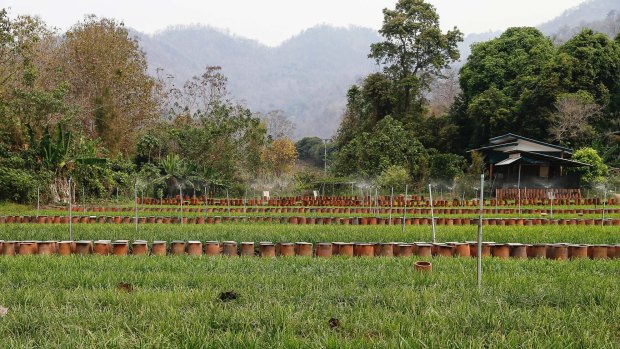
The experimental crops.
More than once as we drive our bog-standard white minivan along the curvy, well-maintained roads, it strikes us that a convertible or motorbike would be a lot of fun.
One such drive takes us to Mon Jam, a resort popular with southern Thais that is part of the Nong Hoi Royal Project, built 1460 metres above sea level. The sweeping views (although today, shrouded in mist) and beautiful gardens are great but it's the meal prepared by the local canteen that interests us most. We graze on five or six dishes distinct to the area, including a pork and peanut curry with spice influences from Burma, India and Thailand. It reflects the diversity and history of this remote, northern Thai area, which over the past 100 years has been a magnet for seven Asian tribes: the Karen, Lahu, Hmong, Lisu, Akha, Mien, and Padaung, each with their own distinctive languages and customs.
In a quiet moment our guide, Sei, fills us in on some historical details. In the beginning, he says, the King funded much of the work out of his own pocket. "But as time goes by the Ministry of Agriculture helped fund [it]. There was also, in the beginning, a lot of funding from many countries – some from the [United] States, some from Germany." While the project has generally been a great success story, according to a recent report in the Bangkok Post it seems poppies – used in the production of banned drugs including opium and heroin – have not been wiped out from the area completely.
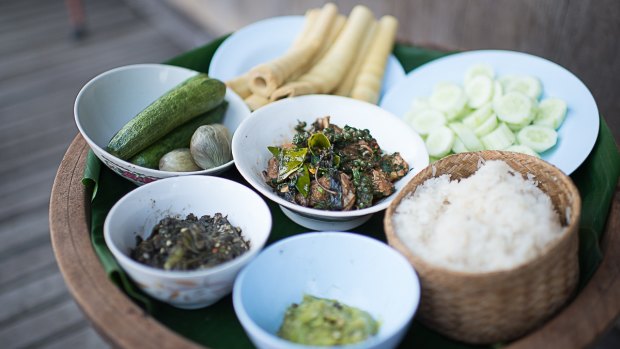
The Royal projects.
While visiting private farms is trickier, Royal Project research centres are open to the public and a great way to understand how the initiative works. At Pang Da Development Centre we see some unusual crops, including more than a dozen espaliered fig trees that grow horizontally at hip height, a grove of star fruit trees and a decent-sized stand of hemp, which is now used for oil and fibre. And before it became illegal, cooking with its close relative, marijuana, was popular, says Sei. "When my father was young he would eat it but in my generation, no more." The herb would be tied up in cloth and added to green curries and beef noodle broths for its sweet flavour and "happy" effect. "I remember [my father] telling me that he drove back at night from one of the restaurants and [was] feeling very scared driving home. Then he realised he was only going at 20-kilometres-per-hour."
Our trips ends with a visit to Chiang Mai market, a staggering collection of street foods, such as nam-pla wan (tart green mangos dipped in a spicy sweet relish), fascinating ingredients (deep fried bamboo caterpillars anyone?) and beautiful hill tribe handicrafts. It's a stark but interesting contrast to the slower life in Thailand's food bowl mountains of Chiang Mai.
TRIP NOTES
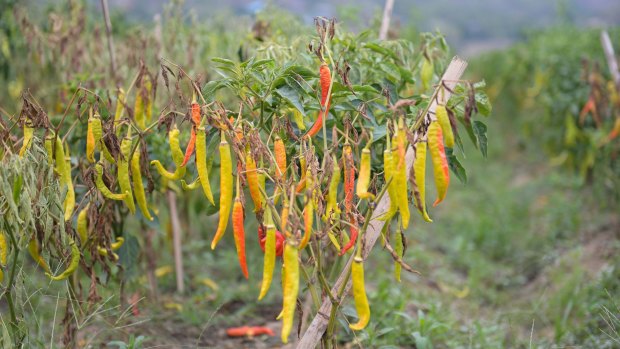
Chillies were introduced in the 17th century.
MORE INFORMATION
www.tourismthailand.org/Chiang-Mai
GETTING THERE
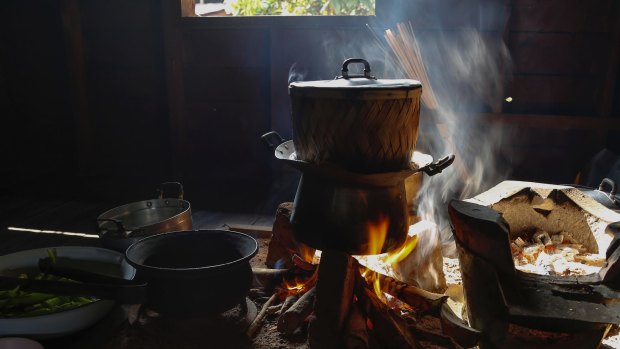
A steaming pot of nam prik num.
Several airlines fly from Melbourne and Sydney with one stopover to Chiang Mai. Thai Airways, for example, flies via Bangkok. See www.thaiairways.com, www.airasia.com, www.cathaypacific.com.au, www.Qantas.com and www.virginaustralia.com
STAYING THERE
For resort-style accommodation, Baan Med Bua is about an hour's drive from the airport and located close to several Royal Project research stations; rooms for two from $95, see facebook.com/baanmedbua.
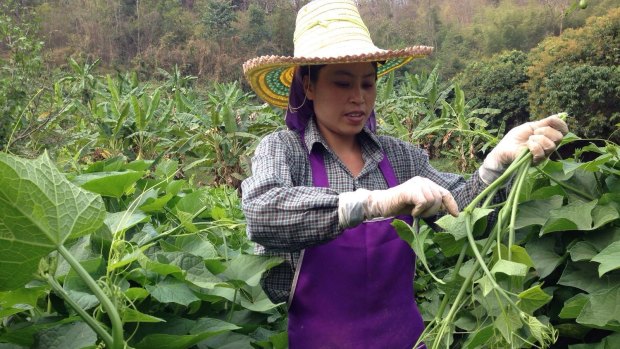
The Royal Project aims to fight deforestation and poverty in Thailand.
SEE + DO
Several cooking courses operate in the Chiang Mai area. Concept Case runs 2.5-hour courses that can include visits to markets and farms. See conceptcaseall.com.
Peter Barrett was a guest of Thailand Tourism and 50 Best Explores.
Five great places to eat in Bangkok
NAHM
Exquisitely balanced flavours cooked by chef-author David Thompson, a world-renowned expert on Thai food. See comohotels.com/metropolitanbangkok/dining/nahm
BLUE ELEPHANT
Authentic Royal Thai cuisine cooked in a colonial setting by local legend, chef Nooror Somany Steppe. See www.blueelephant.com
CHINATOWN
An array of exciting street food for more adventurous diners. Head to Charoenkrung Road, evenings only. See www.bangkok.com/chinatown
SOMTUM DER
An excellent, value-for money introduction to north-eastern Isan Thai food in a casual but clean restaurant. See www.somtumder.com
SMALLS
This grungy-but-chic three-storey bar in Sathorn does snacky food, live jazz and up to 10 different absinthes. See facebook.com/smallsbkk
Sign up for the Traveller Deals newsletter
Get exclusive travel deals delivered straight to your inbox. Sign up now.